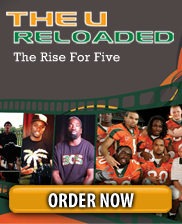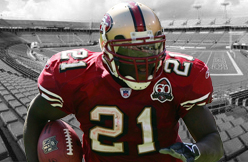Jan/31/12 09:00 AM Filed in:
Frank GoreThe 49ers began the 2011 season with a power-running offense, one that leaned heavily on workhorse tailback, Frank Gore. At the midpoint of the season, however, something changed. Gore became less of a focal point, and the 49ers went from a team that ran more than it threw to one that called 33 pass plays against 24 run plays in the NFC Championship game. That seemed odd, especially for a team that was built for power football in December and January and for an offensive unit whose most valuable weapon for years had been its running back.
The explanation is partly due to the way defenses played the 49ers - they decided that San Francisco's passing game was the lesser of the two evils. And that itself is a very good reason for the team to spend a good chunk of its offseason capital bolstering the passing game with pass catchers.
But it also was because of Gore. He did not suffer a serious injury like he did in 2010 when he broke his hip. But his heavy workload at the beginning of the season left him with an array of nagging, smaller injuries by midseason that, according to a source with knowledge of Gore's condition, kept him from shouldering the same load he did at the beginning of the season.
As Gore's workload began to wane over the second half of the season, observers figured the 49ers were saving him for the playoffs, and that his role would return to normal in January. That didn't happen. Gore, who will turn 29 in May, averaged nearly 20 carries over the first half of the season. He averaged 15 in the second half and the playoffs.
When Gore had the ball in his hands, he seemed to fine. But he often removed himself from games at the end of the season and in the playoffs. During a critical fourth-quarter drive against the Giants in which the 49ers ground attack appeared to be gaining the advantage against the New York defense, it was third-string runner Anthony Dixon who entered the game. He was tripped up on a potentially big run on 2nd and 4, and ended up gaining three yards. On third and 1, he was stopped for no gain.
What occurred in 2011 points to the 49ers adding a runner in the offseason.
The 49ers may have overused Gore early in the season, but what other choice did they have? The passing game was still in its infancy, and the two other running backs on the roster were, in Kendall Hunter, a rookie, and in Dixon, a young runner who still hasn't won over the coaching staff. Dixon carried the ball only 29 times in the regular season and averaged three yards a carry. Gore averaged 4.3 yards and Hunter 4.2.
Hunter proved to be a pleasant surprise, hitting the line of scrimmage sharply and taking care of the football. But the 49ers see him as more of a change-of-pace runner. Even if the 49ers added a wide receiver - or two or three - in the offseason, they still are a team that at its core wants to overpower defenses and run the ball down their throats. That's something they were unable to do at the most critical part of the season and something they will have to remedy in the offseason.
49ers top rushers
Frank Gore: 282, 1211 yards, 4.3 avg.
Kendall Hunter: 112, 473 yards, 4.2 avg.
Alex Smith: 52, 179 yards, 3.4 avg.
Anthony Dixon: 29, 87 yards, 3.0 avg.

(sacbee.com)



